Report

Резюме
- Electric vehicles (EVs) could account for more than 40% of India’s automotive market and generate over $100 billion of revenue by 2030.
- Achieving this will require concerted strategies across five areas: new product development, go-to-market/distribution, customer segment prioritization, software development, and charging infrastructure.
- Several of these interventions will require category-specific stakeholder action.
Executive summary
India’s electric vehicle (EV) market is at an inflection point. EVs accounted for about 5% of total vehicle sales between October 2022 and September 2023—and could reach more than 40% penetration by 2030 (see Figure 1), driven by strong adoption (45%+) in both two-wheeler (2W) and three-wheeler (3W) categories.
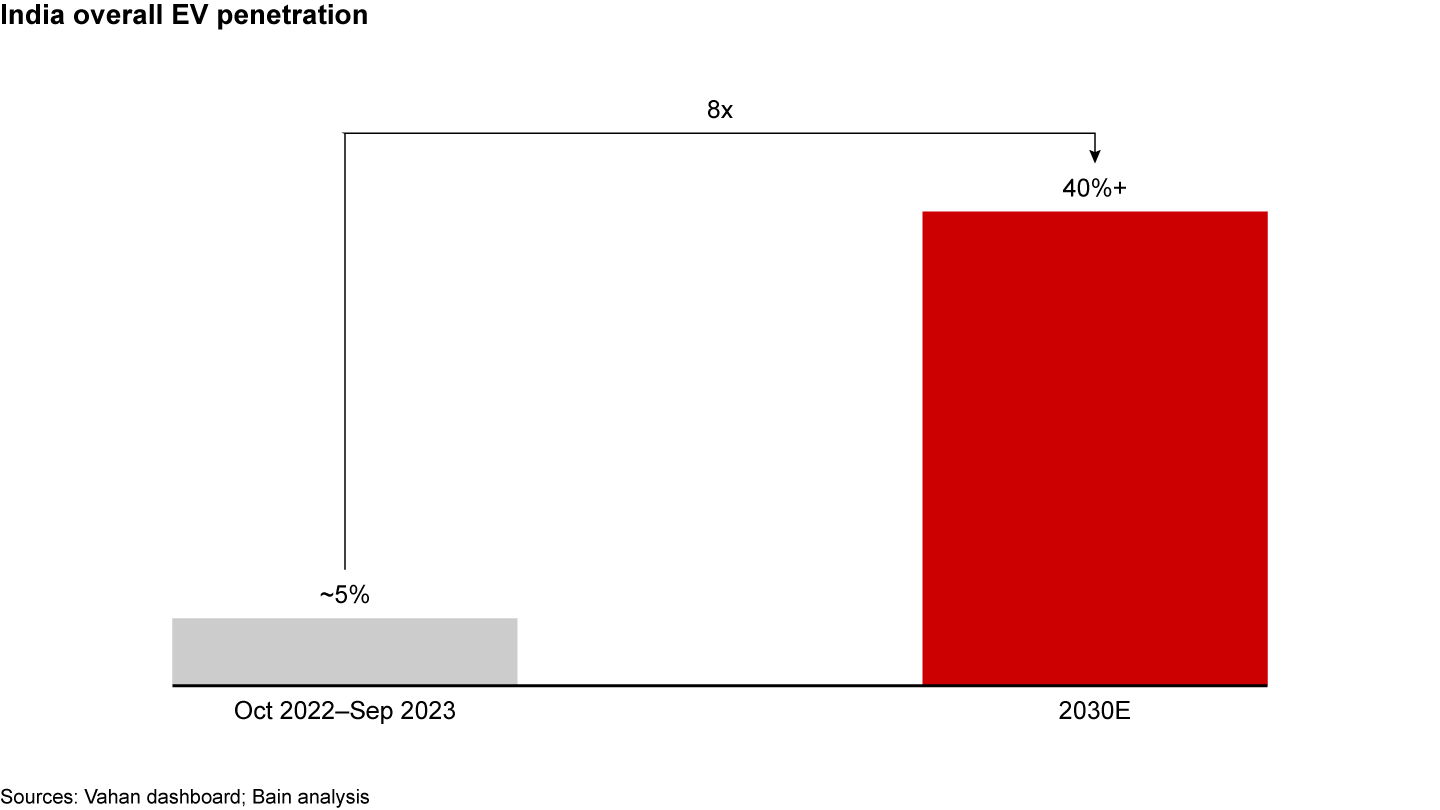
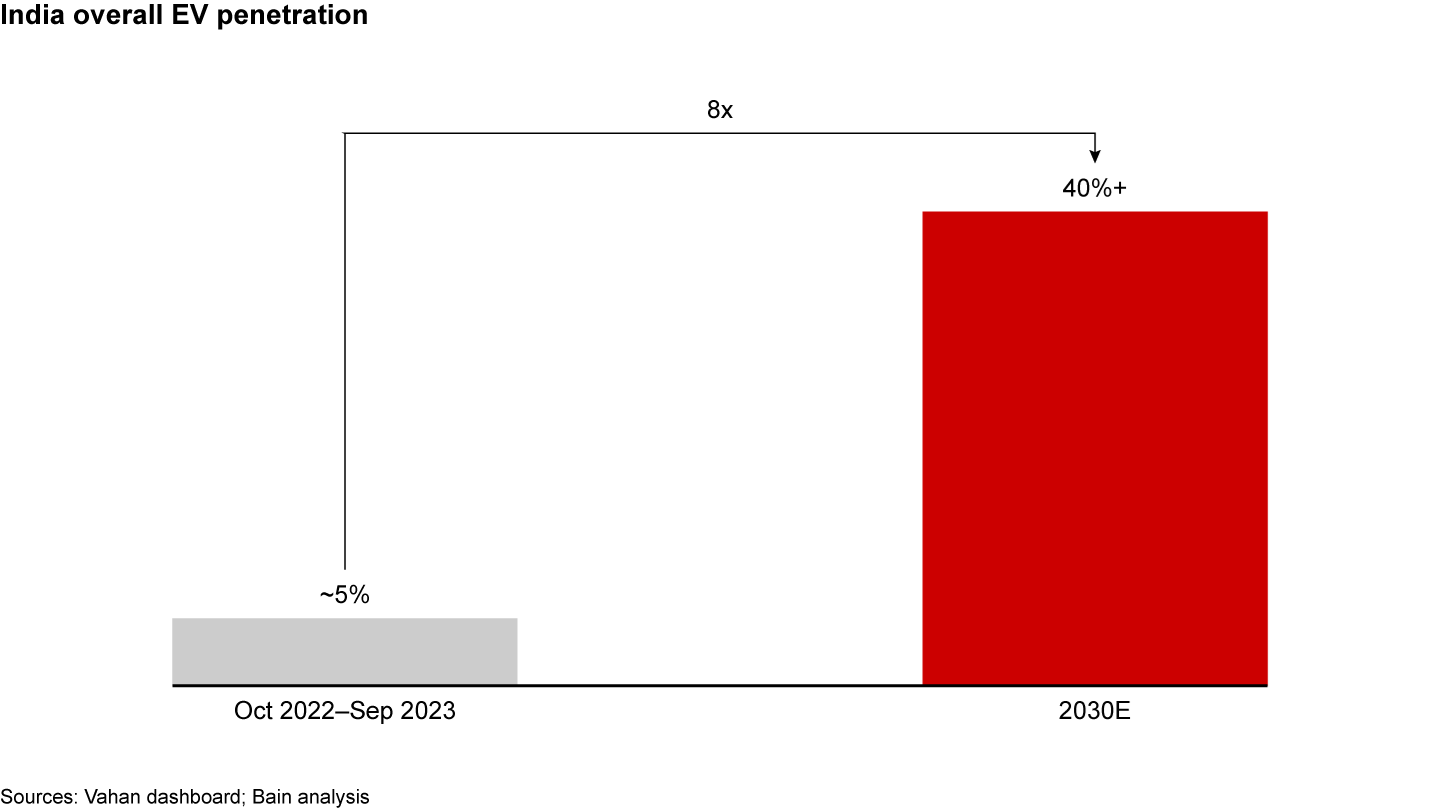
However, several structural challenges need to be addressed to spur increased EV adoption. For example, EVs are currently priced higher than internal combustion engine (ICE) vehicles. There’s also anxiety over range, limitations in charging infrastructure, and friction in customer financing.
2W EVs form the majority of EV sales today, accounting for 85%–90% of all EV units sold in India, followed by 4W EVs (7%–9% of sales) and 3W EVs (5%–7% of sales). While Phase II of the Faster Adoption and Manufacturing of Electric Vehicles (FAME) scheme was recently revised, 2W EV penetration has remained stable at around 5% in line with Jan–Mar 2023 levels (and only a marginal decline in Jun–Jul 2023). 3W EV and 4W EV penetration levels experienced an upswing, with volumes more than doubling over the past 12 months, driven by low total cost of ownership (TCO).
Written in collaboration with
Written in collaboration with

To realize its $100 billion revenue potential, India’s EV market needs to grow more than tenfold in volume over the next 6–7 years. This is achievable, but only with focused interventions across five key areas: new product development, GTM/distribution optimization, B2B focus, software development, and scale-up of charging infrastructure.
These interventions are above and beyond the macro elements that also need to be addressed, such as policy support, safety improvements, and battery price decline—all of which are expected to play out in “business as usual.”
Five focus areas for interventions
1. Develop “customer-back” products to optimize capital expenditure.
EV penetration is significantly higher in the premium segments than the mass market, as EV manufacturers aim to balance pricing with range and performance. Most EV categories are already TCO-positive at threshold range, which makes them attractive as fleet and B2B vehicles. However, mass adoption requires pricing parity with comparable ICE models (e.g., Honda Activa among 2Ws and Bajaj RE among 3Ws), even if that entails compromises in range and performance.
Doing this will be no trivial task. OEMs will need a deep understanding of customer segments to build EVs that meet their needs, especially with respect to range and performance. In addition, for better economics, OEMs may need to reduce “nice to have” features from existing premium models when subsidies expire.
2. Reimagine distribution models to grow beyond metro and Tier 1 cities.
Metro and Tier 1 cities currently drive the majority of EV sales. For example, metro/Tier 1 cities account for 80%–90% of 3W EV sales, compared to only 55%–65% of comparable 3W ICE sales. This is driven by lower EV distribution footprint in Tier 2 cities, limited customer understanding of EVs’ TCO benefits, and high range anxiety among Tier 2 customers.
Replicating ICE dealership models is unlikely to work in Tier 2 cities since EV dealerships generate less service revenue. EV models have lower service requirements, with a lower number of components, hence service revenues only comprise 10%–15% of EV dealer revenues (compared to 30% or more for ICE dealers). As a result, OEMs have to operate with higher margins, lower cost structures (via “lean” dealer operations, lower headcounts, or direct-to-consumer sales), or a combination of both over time.
OEMs also need to balance speed required to capture untapped markets with the right dealership operating model (e.g., exclusive dealerships vs. multi-brand outlets), in order to achieve scale and profitability over the long term.
3. Prioritize B2B/fleet customer segments to generate near-term momentum.
OEMs can accelerate EV adoption by targeting B2B customers and fleets, such as food/grocery delivery platforms, logistics firms, and cab fleet operators. EVs offer a superior value proposition for these segments based on positive TCO, which is reflected in their ambitious electrification plans. For example, Amazon plans to add 10,000 EVs to its India logistics fleet by 2025, Zomato aims to electrify 100% of its delivery fleet by 2030, and Uber plans to add 25,000 EVs by 2026 as part of its “Uber Green” initiative.
OEMs need to double down on the B2B and fleet segment to scale, despite potentially weaker margins. This will necessitate dedicated organizational bandwidth targeting this segment, deliberate product customization to address customer requirements, and a long-term partnership model to help EV OEMs continually tailor their products to meet B2B/fleet customers’ needs.
4. Use software as a differentiator and profitability driver.
Profitability and cost optimization are significant challenges for OEMs, especially as they try to drive adoption and scale, and must be addressed to ensure long-term business viability. Software can help OEMs materially improve their economics by adding new revenue streams and simultaneously improving vehicle performance. For example, OEMs can leverage software to enhance power delivery, optimize battery management based on vehicle usage to increase battery life, etc.
Global EV OEMs like Tesla extensively use software to enable superior safety, battery management and improve the overall customer driving experience. Some of Tesla’s software-driven functionalities include auto-pilot functions, software-controlled all-wheel drive, live traffic visualization, etc.
OEMs need to understand customer needs across segments, and then develop native software capabilities to extract better, differentiated performance from their hardware.
5. Scale charging infrastructure.
India significantly lags other geographies on charging infrastructure, with roughly 200+ EVs per commercial charging point in India, as compared to ~20 in the US and less than 10 in China. India needs both slow- and fast-charging infrastructure, through establishing more charging points in existing EV areas, as well as widening pin-code coverage to reduce range anxiety.
Battery swapping (offered by companies like Sun Mobility and Battery Smart) can also potentially solve the infrastructure gap in select commercial use cases, such as passenger 3W EVs and 2W EVs for last-mile deliveries etc., while simultaneously lowering upfront costs, increasing earnings potential (due to low down-time), and improving flexibility for customers. OEMs need to prioritize the right use cases, optimize product designs, and partner with battery-swapping players to address a wider range of customer segments.
India’s 2W EV Market
India’s 2W EV penetration has potential to jump from approximately 5% today, to 45%+ by 2030. However, realizing this massive opportunity requires OEMs to have a multipronged development agenda, supported by key unlocks at the EV ecosystem and policy levels (see Figure 2).

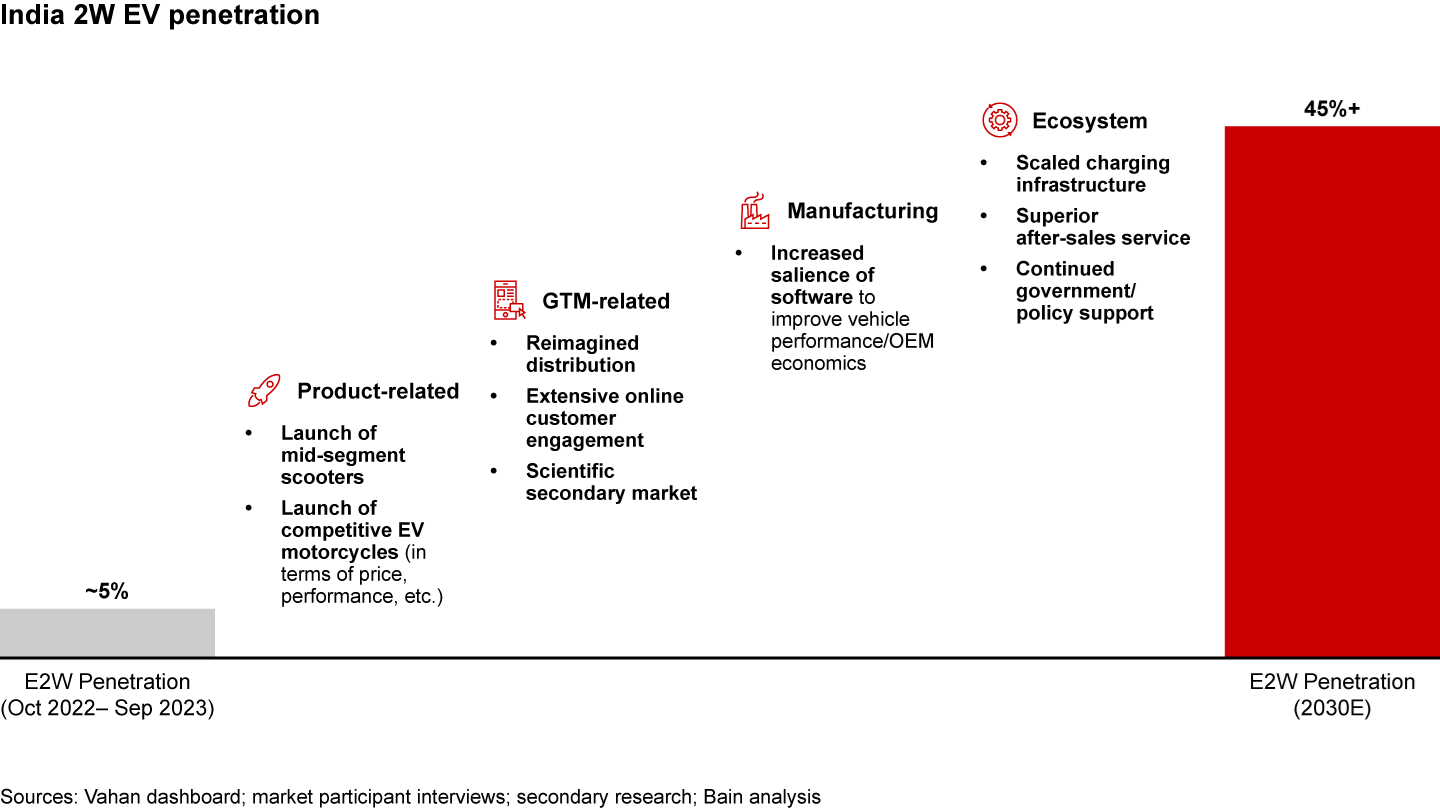
2W EV product unlocks
A mid-segment EV scooter product could enable 50%+ penetration in scooters, a huge jump from 10%–15% penetration today. While EVs have already achieved 40% penetration in the premium scooter segment, the dominant mass/ economy segment—constituting ~75% of the market—is largely untapped.
To achieve over 50% EV penetration in scooters, OEMs need to launch new products to displace dominant models like Honda Activa (e.g., Ola recently made headway by introducing its S1X scooter priced at INR 90K). However, this will be challenging for OEMs who are struggling to balance vehicle cost with range and performance.
Instead of de-specking existing premium products, OEMs will need to take a ground-up, “customer-back” approach to product development, developing products specific to key customer cohorts, and balancing range and performance at the Activa price point. Over time, product development in the mid-segment will be complemented by scaled domestic manufacturing and falling battery prices, which will further help accelerate penetration.
Breakthrough motorcycle products could propel motorcycle EV penetration to 30%+, up from less than 1% today. So far, EV motorcycles haven’t matched ICE models on most key customer purchase criteria, including price, range, and top speed. Majority of the current EV offerings are ~50% more expensive, have ~25% lower top speeds, and ~80% shorter range vs. ICE models. The only criteria where current EV motorcycles are on par with ICE models is TCO.
While premium EV scooters have gained traction, it will be difficult for premium EV motorcycles to match the performance of premium ICE motorcycles at comparable prices. However, the entry-level segment, which constitutes roughly half of the overall motorcycle market, is more amenable to EV penetration, driven by lower range and performance thresholds. If OEMs can match the price and performance of existing entry-level ICE vehicles like Hero Splendor, EV penetration might grow even further.
Battery swapping will enable lower-cost offerings. Offering 2W EVs without batteries would reduce the upfront cost of EVs by 40%–50%, helping drive adoption in the entry- and mid-level segments, given relatively higher price sensitivity among those customers. However, availability and purchase of 2W EVs without batteries will require scale-up of specialist battery swapping players. For example, in Taiwan, Gogoro built an extensive battery-swapping network with more than 2,500 stations, deploying more than 1 million batteries. Gogoro’s ability to scale was driven by interoperability, as it shared key kits/components across top OEMs and entered into battery swapping partnerships with them.
Building the same ecosystem in India will be challenging, since OEMs are unlikely to standardize their batteries in the near term. Instead, swapping players will need to maintain inventory for top SKUs across OEMs and identify customer segments to target (e.g., delivery platforms with large fleets of 2W EVs or retail customers with EVs from the top four or five OEMs). OEMs also need to strike “walled-garden” partnerships with battery-swapping players to support swapping-enabled 2W EV models.
2W EV GTM unlocks
A re-imagined distribution model will be key to driving 2W EV penetration. The traditional distribution model would put margin and cost pressures on EV OEMs as EV dealerships earn only about 10%–15% of their revenues via service and parts as compared to 30%+ for ICE dealers, given EVs involve fewer components and infrequent repairs. Additionally, human resources costs are also 40%–50% higher for EV dealers, owing to need for employees with higher software and electrical skills, and more extensive training.
It is critical for EV OEMs to reimagine the dealership model and its value proposition, including the creation of lean experience centers, optimized store sizes and infrastructure, and rationalization of store staff. OEMs also need innovative distribution models, such as scaled multi-brand dealerships, to drive higher volume and profitability, with multi-brand dealers in turn needing to conduct rigorous staff trainings to help them effectively sell products from multiple brands.
New online channels (e.g., community-led D2C, digital-led lead generation) will also emerge to support 2W EV sales. Buying behaviors are changing, with “research online and purchase offline” becoming the norm and 50%+ of 2W sales expected to be online-enabled by 2030, up from less than 10% today.
It will be critical for OEMs to redefine their engagement models across the customer funnel through focused digital initiatives. For example, Google advertising on 2W marketplaces (e.g., BikeDekho, ZigWheels) and social media/influencer-led ads to help drive top-of-funnel awareness; content such as blogs, demo videos, and client testimonials to drive engagement; readily available online financing to propel conversions.
Enhanced customer engagement via online channels has already seen some traction in other developed regions. For example, Tesla built out strong online sales and marketing capabilities, including an online car configurator, the Tesla Engage platform, a direct home delivery service for vehicles and regional, state-wide Tesla ownership clubs to build community engagement.
A “scientific” secondary market will be key to drive EV penetration in India. Other markets like the US and China have established secondary markets for EVs, backed by detailed data on vehicle performance (e.g., battery capacity and health, total distance, and well-defined heuristics for price discovery of used batteries). For example, for 4Ws, China has secondary players such as Uxin, Guazi, and Alibaba, and the US has Autotrader, Copart, and Carmax—all of which collectively improve liquidity and drive EV penetration.
Additionally, EV battery depletion has in reality been slower than OEMs originally estimated, which will enable higher tradability for 2W EVs. A secondary market could be a lucrative opportunity for platforms in India, either through OEM buy-back schemes, OEM-led secondary marketplaces (similar to Maruti or other luxury car brands), or through third-party marketplaces similar to CarDekho, Spinny, or Cars24 in the 4W space. Presence of a secondary market helps establish a credible salvage value for EVs and also enables lower financing costs for customers.
2W EV manufacturing unlocks
A localized supply chain and India-specific component innovation would significantly accelerate EV penetration. India currently relies on China to provide 60%–70% of key EV components, including lithium-ion battery cells, e-motor magnets, and other electronics.
While battery cells will continue to be imported in the short to medium term, India must accelerate domestic production for other components to limit supply chain reliance (and shocks) from China. This will also drive component innovation relevant to the Indian market, such as higher payload capacity, longer range for customers in Tier 2+ cities with poor charging infrastructure, and improved battery heat-resistance to counteract high temperatures in India. Domestic production and innovation would in turn enable higher availability and lower cost of spare parts, which is a key pain point for brands and customers today.
OEMs must explore alternate revenue streams via software and value-added services to improve economics. Since EV dealerships earn lower service revenues, OEMs need to explore new sources of income, including customization options, accessories, and recurring subscription-based services (such as predictive maintenance alerts, in-car Wi-Fi, or roadside assistance). For example, Tesla charges about $10 per month for premium connectivity features like live traffic visualization, video streaming, and karaoke.
OEMs need a deep understanding of their customers’ needs to develop differentiated software and create superior customer experiences.
2W EV ecosystem unlocks
India needs to accelerate charging infrastructure development to ease customers’ range anxiety. For context, India has roughly 200 EVs per commercial charging point, as compared to approximately 20 in the US, and less than 10 in China. Public charging infrastructure in parking lots, restaurants, and other gathering spaces needs to grow at a much faster pace relative to EV sales to help bridge this gap.
In the short term, this will largely be led by slow-charging stations, with fast charging restricted to emergency/top-up use cases at a premium. OEMs and charging players like ElectricPe need to build scaled partnerships with key stakeholders such as real estate players and restaurant chains to accelerate infrastructure development.
After-sales service is a big pain point for EV customers, with lack of adequate service centers, either third-party or in-house. Select OEMs like Ampere have partnered with players like ReadyAssist to provide round-the-clock after-sales vehicle assistance. However, the scalability of this model is unproven. Even mature players in other regions like Tesla are struggling to deliver superior post-sale experiences, despite significant investments in service center operations and mobile service stations. Tesla has earned less than 5% net margin on servicing revenues over the last 3–4 years.
It is critical for Indian OEMs to provide superior after-sales services, helping drive customer loyalty and long-term EV penetration. OEMs will need to make tradeoffs between maintaining in-house service centers and enabling localized third-party providers. The right strategy will vary by brand, product segment, price points, etc.
Lastly, India also needs sustained policy support to enable localization (beyond just batteries) and drive EV adoption. For example, governments need to define clear norms for fast-charging infrastructure, with tax breaks for charging infrastructure set up, policy support to lower the upfront cost of EVs and production-linked incentives to accelerate EV component manufacturing.
India’s 3W EV Market
India’s overall 3W market grew at a steady pace (6%–8% per annum) between fiscals 2017 and 2023, with EV penetration surpassing 50% in fiscal 2023, up from approximately 10% in fiscal 2017.
Penetration growth is partly attributed to government bans and the consequent phase-out of traditional petrol/diesel 3W vehicles. For example, the government of Delhi capped 3W vehicle registrations at 100,000, with EV models given high priority for new permits. Additionally, superior TCO of 3W EVs, and launch of lower-priced, permit-free e-rickshaws have driven rapid growth.
Within 3W EVs, e-rickshaws constitute the majority of sales, accounting for approximately 90% volumes (~375,000 vehicles) and are primarily used for short-distance commutes. E-rickshaws also entail lower upfront costs compared to ICE 3Ws, which has helped drive accelerated adoption. For example, the Kinetic Safar Smart e-rickshaw costs INR ~1.5L, as compared to the ICE-based Bajaj Compact RE costing INR ~2.3L.
EV penetration is lower among 3W passenger vehicles and 3W cargo vehicles (5%–10% and ~20% respectively), driven by higher upfront costs, and a lack of sufficient EV models with the right specifications.
Going forward, 3W EV penetration (excluding e-rickshaws) is expected to scale rapidly, jumping from current ~10% to 45%+ by 2030, with secular growth across segments: 3W passenger EVs are expected to grow from 5%–10% to 35%+, and 3W cargo EVs could triple penetration from ~20% to 60%+.
To make this leap, OEMs and EV ecosystem partners need to make significant investments in key areas, including new product development, dealer network expansion, strong B2B focus, and scaled up infrastructure for battery charging and swapping (see Figure 3).


3W EV product unlocks
OEMs need to develop 3W passenger EVs matching compressed natural gas (CNG) counterparts. EV penetration in 3W passenger vehicles is only 5%–10% at present, due to current models costing ~25% more than CNG alternatives and having ~30% lower range. For example, Mahindra Treo EV costs INR ~3L and has ~140 km range, while Piaggio Ape City CNG costs INR ~2.3L and offers ~200 km range.
It is imperative for OEMs to introduce 3W EVs at lower price points (around INR 2.5L), even if this entails lower range as compared to CNG models. This will enable EV adoption for last-mile/localized use cases within a 5–15 km radius around hotspots like metro stations, malls, markets, and offices, which account for 40%–60% of all 3W passenger trips.
OEMs will need to innovate (or make mechanical tradeoffs) to offset range limitations, with measures like kerb weight reduction via use of cheaper or lighter materials, which could reduce costs and generate comparable power despite using smaller batteries. They can also innovate to drive higher powertrain efficiencies via use of technology.
In 3W cargo, introduction of an entry-level EV model will be key to propel EV adoption. 3W cargo EVs currently offer better TCO and higher payload capacities than ICE models—yet penetration is low at ~20% because prices are substantially higher (by roughly 30%).
For example, Piaggio Ape E Extra FX (EV) costs INR ~3.1L, as compared to INR ~2.4L for Piaggio Ape Xtra LDX (ICE) while both have comparable payload capacity of ~500Kgs. While other EV models like Euler HiLoad and Mahindra Treo Zor have higher payload capacities (~690kgs and ~550kgs respectively), current prices for these 3W EV cargo vehicles are not far from 4W ICE cargo vehicles, which have even higher payload capacities and higher top speeds.
OEMs need to launch new EVs at the INR 2.5–3L price point and provide performance in line with the segment’s standards (450–500 kg payloads, 55–60 kmph top speeds) to drive wider EV adoption. In addition to de-specking, potential exists for OEMs to reduce prices by innovating to increase battery/powertrain efficiencies, as well as considering mechanical trade-offs such as kerb weight reduction to in turn use smaller and cheaper batteries.
3W EV GTM unlocks
Offline dealer networks are critical for 3W EVs to take off, due to the prevalence of consultation-based sales. The low number of EV dealerships is hence a major roadblock to 3W EV penetration today. For example, Piaggio has about 10 3W EV dealerships compared to a total of about 35 in Maharashtra. Similarly, in Gujarat, only a third of Piaggio 3W dealerships stock EVs. Insurgents lag even further behind, with Euler and Altigreen having about 50 dealerships pan-India, as compared to Mahindra’s 600. Additionally, major OEMs have limited EV presence beyond metro and Tier 1 cities, which is reflected in their sales mix—Tier 2 cities account for 35%–45% of ICE 3Ws, but only 10%–20% of EV sales.
OEMs need to scale their distribution footprint through strategic network planning, which includes prioritizing micro-markets for entry in states with high 3W vehicle demand, such as Uttar Pradesh, Karnataka, Maharashtra, etc.
OEMs need to strengthen their B2B-specific GTM capabilities and deepen engagement with B2B customers to accelerate EV penetration. Commercial vehicle ownership is fragmented across both e-commerce/logistics companies providing third-party and fourth-party logistics services, and a large base of small-fleet owners—with about 50% of commercial vehicles being owned by companies with five vehicles or less.
3W cargo EVs are optimal for these customers, particularly for intra-city local transportation, where predictability in routes and high utilization significantly reduce the time to achieve positive TCO relative to ICE vehicles. Additionally, logistics companies are under pressure to optimize shipping and logistics costs, which will fuel EV adoption.
There are some early signs of OEMs forming B2B partnerships, such as Euler supplying 3W EVs to Udaan, EcomExpress, and BigBasket. However, there is significant untapped potential. For example, Flipkart plans to transition its fleet entirely to EVs by 2030; Amazon plans to introduce 10K EVs in its final-mile delivery fleet by 2025. To capitalize on this opportunity, OEMs need to strengthen their B2B capabilities, which include key account management structures with single-window interfaces, dedicated B2B sales and support teams, providing annual maintenance-inclusive contracts, and the ability to customize products per customers’ specs.
3W EV ecosystem unlocks
Similar to other automotive categories, scaled battery charging and swapping infrastructure will provide a fillip to 3W EV penetration. Battery swapping will gain prominence, particularly among 3W passenger EVs with daily runs of 175–200 km, given the lower upfront cost (batteries currently account for 40%–50% of 3W EVs’ cost), and flexibility to pay per use instead of for the entire battery upfront. Battery swapping is also faster and entails significantly lower downtime vs. charging. It takes 1–3 hours to charge a battery, but only 10–15 minutes to swap one out, which results in over 30% higher earning potential for customers.
Battery swapping players like Sun Mobility and Battery Smart need to rapidly scale to support 3W EV adoption, as India significantly lags other countries in battery swapping infrastructure currently. For context, Taiwan has nearly twice as many swapping stations as India—with more than 2,500 stations as compared to India’s ~1,500.
India’s 4W EV Market
India’s overall 4W market is large: 4–5 million units were sold in fiscal 2023, with the market growing steadily at ~2% compound annual growth rate (CAGR) between fiscal 2018 and 2023.
While current 4W EV penetration is low at 1%–1.5%, 4W EV sales have grown rapidly at 85%–90% CAGR over fiscal 2018–23, albeit on a small base. Penetration has been constrained by limited choices of EV models (particularly in commercial 4W, buses/trucks), high upfront costs as compared to ICE models, and an inadequate charging ecosystem.
Within the 4W EV market, cars form the majority, accounting for 90%+ of EV sales, driven by select OEMs offering EV models with premium features that enhance safety and comfort, such as advanced driver assistance systems. Buses and truck/cargo segments have seen limited EV volumes and penetration (~3% and ~0.1% respectively), owing to few available models, range anxiety, and lack of charging infrastructure.
EV car penetration could jump manifold from approximately 1.5% to 20%+ by 2030, if EV stakeholders undertake significant interventions. OEMs need to develop new products at competitive price points, expand dealer networks, build software capabilities, and scale charging infrastructure (see Figure 4).
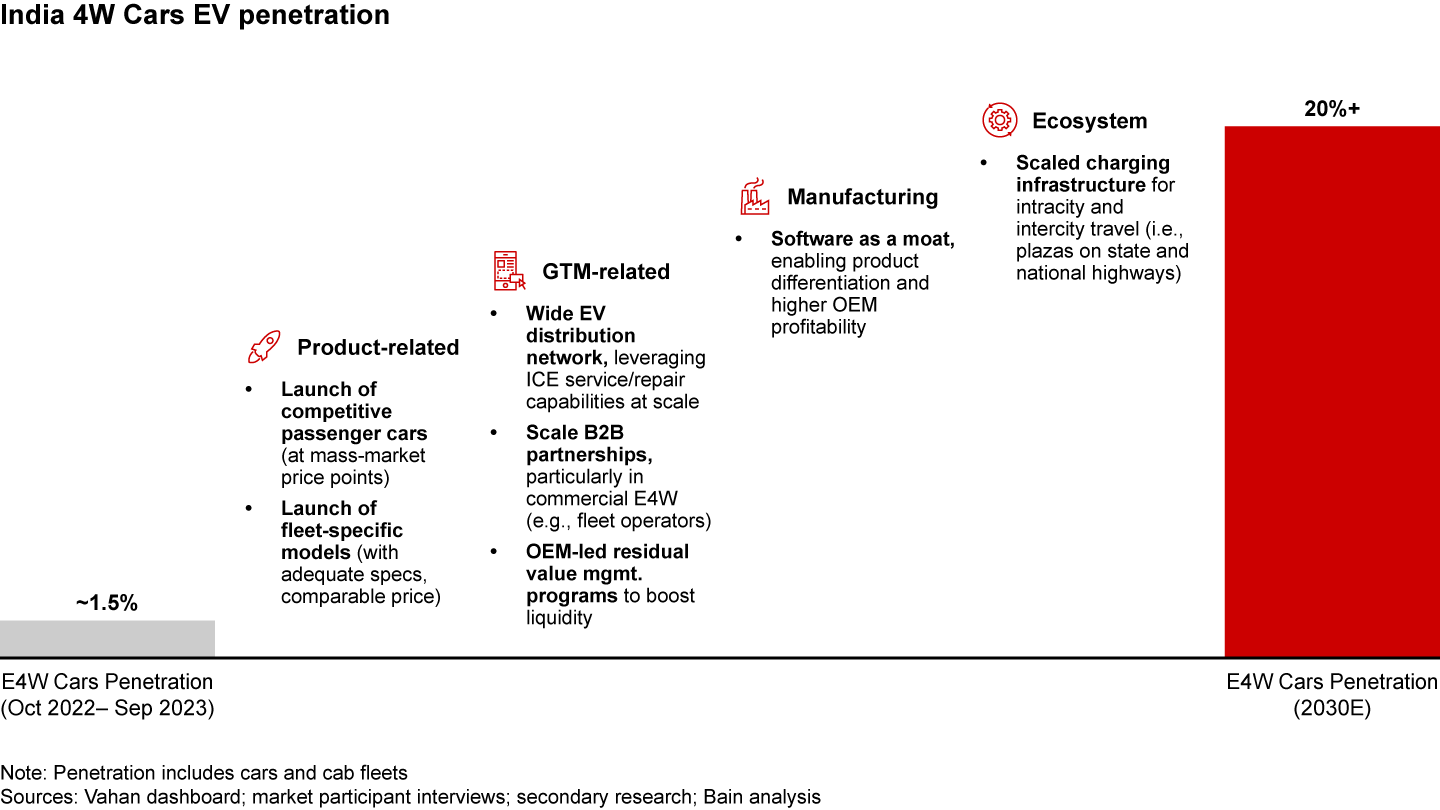
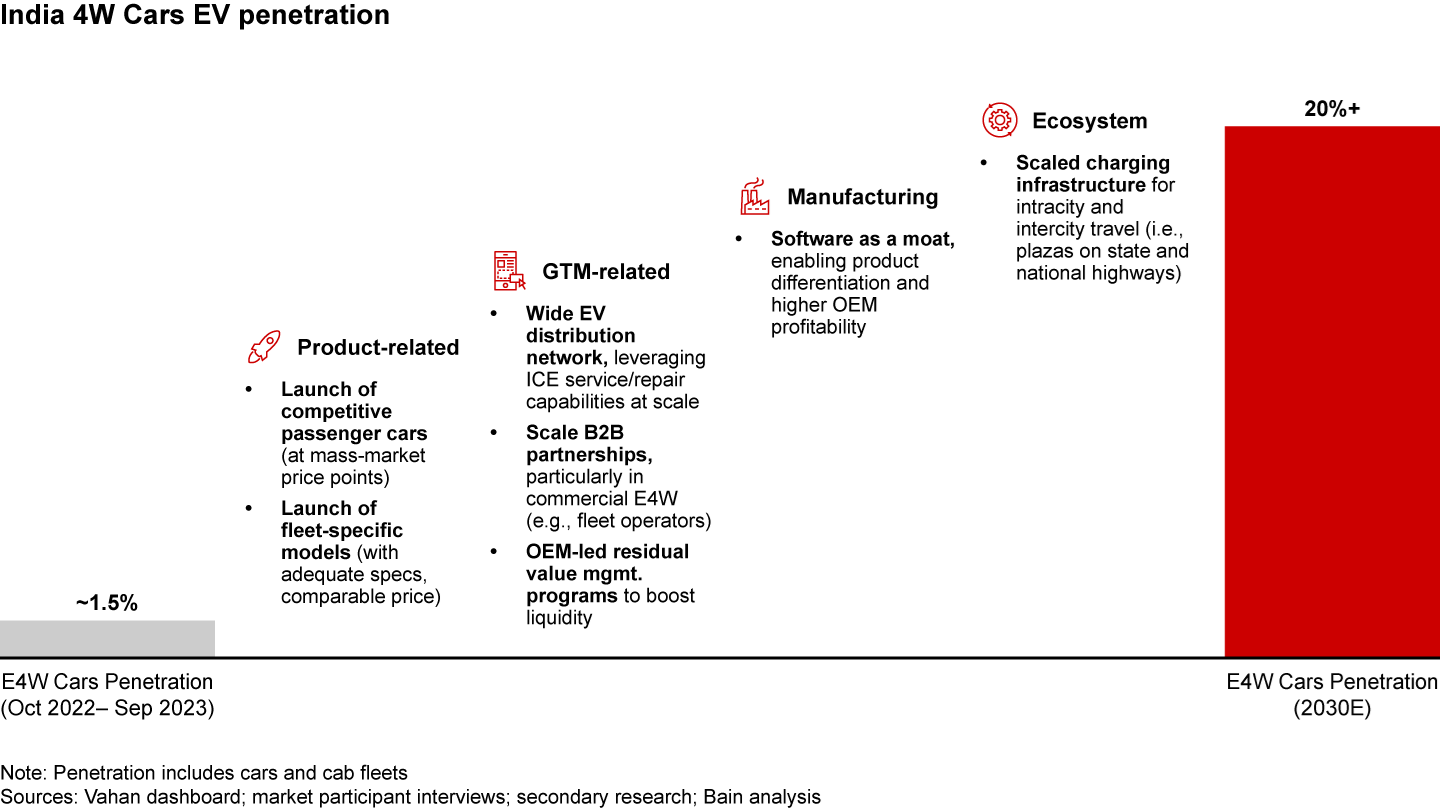
4W EV product unlocks
Launch of a fleet-specific EV model at the right price point to accelerate penetration in passenger 4W. The market currently lacks an economical 4W passenger EV designed for fleets, with current EV models priced significantly higher than ICE or CNG models. For example, the fleet-focused Tata Xpres-T EV costs INR ~13L, which is ~75% more than the Maruti Dzire Tour CNG (INR ~7.5L).
Successful fleet-focused ICE/CNG models in the past have scaled on the back of lower prices vs. non-fleet models, fleet-specific features, and best-in-class fuel efficiency. For example, the fleet-only Dzire Tour model sold ~30,000 units in fiscal 2023, in addition to ~120,000 non-fleet units. The fleet-specific Dzire Tour CNG variant costs INR ~7.5L, compared to INR ~8.5L for non-fleet CNG model and INR ~7.8L for the Tata Tigor CNG, and it has best-in-class fuel efficiency of ~32 km/kg compared to ~26.5 km/kg for the Tata Tigor CNG.
Servicing the increasing demand for “green” fleet vehicles will require OEMs to introduce tailored products for this market at the right price points (INR 8–10L for sedans), and with fleet-specific features like speed-limiting and comfortable rear seats. Lower prices, and the commensurate lower range and performance (as compared to ICE vehicles), will limit EV fleets to intracity use cases, while ICE fleet models will continue to serve intercity routes.
The 4W EV market needs more entry-level cars and utility vehicles. Current EV penetration has been limited to ~1.5%, due to higher prices, shorter range, and lesser power. EV cars cost roughly 50% more, have 50%–60% lower range, and ~30% less engine power as compared to comparable ICE models. For example, the Tata Tiago EV costs INR ~8.7L, has a range of ~250 km, and ~60 bhp power, as compared to the Tata Tiago ICE which costs INR ~5.6L but has a range of 600+ km and ~85bhp power.
In comparison, the US car market had 6%–8% EV penetration in 2022, driven by a wide range of mass-market EV models for customers to choose from. For example, Tesla’s initial models (S and X) targeted the premium market, while subsequent models (3 and Y) catered to the mass markets; Nissan launched the Leaf and Chevrolet launched the Bolt EV, both with entry-level prices, in the range of $25,000–$30,000.
Accelerated EV adoption in India will necessitate price-competitive EV car models, which will further be enabled by a decline in battery prices as the market attains scale, as well as “fit-for-purpose,” EV-first platforms for the mass market.
4W EV GTM unlocks
Extensive OEM-led distribution networks will be key to scaling electric cars in India, to be able to suitably demonstrate the benefits of EVs over ICE models, and justify the higher upfront costs to customers, despite the more favorable long-term TCO.
This will require OEMs to define a clear EV network footprint beyond just metros, Tier 1 cities, and top states. For example, Tata Motors has about 1,500 dealerships across India, of which only about 250 sell EVs; the top 3 states of Maharashtra, Karnataka, and Uttar Pradesh constitute only ~25% of all dealerships, but ~70% of all EV dealerships.
OEMs will also need to determine the right EV channel structure (dealership-led, direct-to-consumer, agency models, etc.), hire and train the right sales staff, and create relevant incentive structures to push EV models. Additionally, existing ICE service and repair networks need to be equipped to proficiently service EVs, by providing access to relevant tools, spare parts, training, and infrastructure.
At the same time, the industry will likely see traction in ancillary services that are already prevalent in global markets like the US, such as customer leasing services (whether OEM-led or via tie-ups with financial institutions), particularly on the back of higher data availability with respect to EVs’ actual performance as compared to ICE models, enabled by Internet of Things (IoT) devices.
Scaling B2B partnerships will be key to accelerate EV penetration in commercial 4W fleets. Presently, half of commercial vehicle sales are B2B-led, with early partnerships already emerging between OEMs and top B2B customers. For example, Uber entered into an agreement to procure 25,000 EVs from Tata Motors, and BluSmart ordered 500 MG ZS EVs for its premium fleets in Delhi and Bengaluru.
Long-term partnerships with cab fleet operators will be critical to drive scale, and will require OEMs to strengthen their B2B capabilities. These include shifting their organizational structures and operating models such as offering integrated fleet management solutions with leasing and financing options, integrated maintenance contracts, etc.
A reliable residual value management mechanism could fuel EV car penetration. A secondary market is essential for the EV car market, even more so than the 2W space, due to the higher upfront costs of cars.
However, given the high degree of nascency and rapid evolution of product portfolios, natural development of “scientific” secondary markets could be substantially delayed in the Indian context. To speed up development, OEMs need to develop residual value management programs via buybacks or other schemes, to provide comfort around liquidity to consumers, until 3P marketplaces evolve to meet this need.
4W EV manufacturing unlocks
Leveraging software as a moat will be key for electric car OEMs. As software and IoT become pervasive in EVs, they will help OEMs differentiate their products and improve performance extracted from the same hardware.
Globally, Tesla (across models), Hyundai (Kona), BMW (iX) offer comprehensive software suites to deliver superior safety, battery management, and vehicle performance. This includes safety features such auto-pilot, emergency braking collision control, blind-spot monitors, lane-keep assist; battery management features to maximize range and battery life based on car and driver data; and other add-on features like software-controlled all-wheel drive to maximize power, regenerative braking to conserve energy and improve range.
Software can also create additional revenue streams to help OEMs improve their margins. Global OEMs such as Tesla have already started piloting programs to monetize their software-led functionalities. While scaled monetization of software is presently unproven, it is likely to gain salience in the long-term, both globally as well as in India.
4W EV ecosystem unlocks
Accelerated setup of a wide charging ecosystem will be important to drive EV adoption, not just within cities but across key national highways and major tourist destinations, given electric cars have shorter ranges than ICE models, which especially affects intercity travel.
Successful infrastructure scale-up in other markets has been driven by heavy government investments via subsidies to both OEMs and customers. For example, the Chinese government invested $25–$30 billion in EV-related tax breaks and subsidies between 2009 and 2022, and exponentially grew the installed base of EV charging stations in China from about 200,000 in 2017 to approximately 1.8 million in 2022.
In the longer term, the requirement for a dense charging network will decrease as battery technology, EV performance, and range improve, which will reduce the need for top-up charging (e.g., the Mercedes EQS 580 already offers 800+ km range on a single charge). However, in the near-to medium-term, OEMs and EV ecosystem players need to scale India’s charging infrastructure to drive EV adoption.
Imperatives for OEMs and the EV ecosystem
OEMs and ecosystem stakeholders need to make concerted efforts to realize the $100+ billion India EV opportunity by 2030. Their efforts should center around five core themes: product development, distribution, B2B focus, software, and charging infrastructure.
- “Customer-back” product development. Developing products tailored to customers’ needs will necessitate OEMs to build distinct customer cohorts, and identify use cases, key needs for each cohort across parameters, such as price, top speed, range, ride comfort, etc. OEMs need to then prioritize high-potential use cases based on market potential and their execution capabilities.
- Reimagined distribution models. OEMs need to maximize coverage of the most attractive markets at a micro-market level. This entails defining the optimal footprint including dealer vs. experience center allocation, and creating micro-market-level plans to scale (including above-the-line and below-the-line investment allocation plans), etc.
To drive favorable outcomes, it will be critical for OEMs to simultaneously solve for dealer profitability (via new models such as multi-brand outlets, especially for 2W EVs due to margin pressure for EV-focused 2W dealers), lean dealer operations, and a clear dealer value proposition (via standardized infrastructure and processes, tiered reward structure, etc.).
- B2B/fleet focus. Given the criticality of fleet sales to near-term economics, OEMs will need to develop an in-depth understanding of B2B customer use cases and needs, and in turn develop customized products and novel contracting models. For example, they could integrate periodic maintenance and service clauses into sales contracts. OEMs will also need to strengthen their B2B capabilities through the right organizational structure, and robust key account management processes, to build and sustain long-term B2B partnerships.
- Software as a differentiator. OEMs need to identify software-related requirements across customer cohorts and build native software capabilities to differentiate themselves in the market, strategically leveraging M&A to reduce time-to-market. Software efforts should be directed towards enhanced safety and driving assistance features, vehicle performance optimizations, and introduction of add-on features such as live traffic visualization, among other possibilities.
- Scaled battery charging and swapping infrastructure. OEMs and EV ecosystem players need to significantly grow charging infrastructure to alleviate range anxiety among customers. This will require meticulous planning for charging networks, including heuristics to allocate fast vs. slow charging locations within each micro-market. Further, they also need to optimize station size and capacity based on vehicle data, and form B2B alliances with real estate stakeholders such as restaurants, malls, offices, and societies.
For battery swapping, OEMs should prioritize the right use cases, optimize product design, and build walled-garden partnerships with battery-swapping players to serve otherwise hard-to-address segments.
Imperatives for private equity (PE) and venture capital (VC) investors
The India EV market experienced an uptick in investment in the past two years, with $1.5–$2B of capital raised in each of 2021 and 2022—a sharp increase from earlier years (less than $0.5B). These investments have predominantly been directed into OEMs such as Tata, Mahindra, Ola, and Ather, among others.
Going forward, India needs significant investor support to realize the $100+ billion EV opportunity. As the landscape evolves, investors need to evaluate potential assets based on five criteria: sustainable competitive advantage, GTM and distribution capabilities, customer feedback/brand perception, talent and culture, and manufacturing and supply chain strategy (see Figure 5).

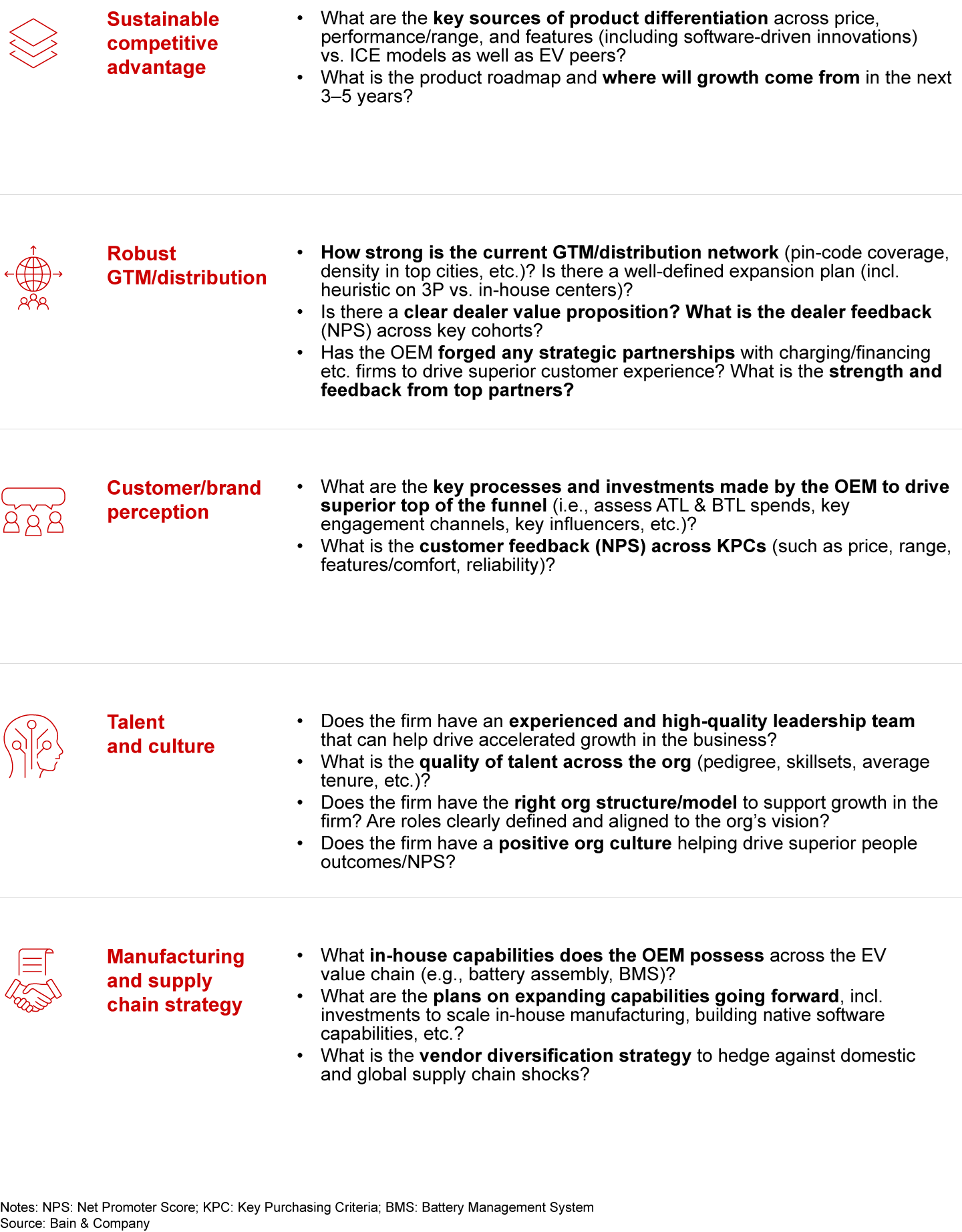

About Blume Ventures
Blume Ventures is an early-stage India-focused venture fund that backs startups with both funding as well as active mentoring. Blume typically invests in Seed and pre-Series A rounds in tech-led startups, led by founders obsessed with solving hard problems, ones uniquely Indian in nature, and impacting large markets. Blume presently invests out of Fund IV, a $300 million vehicle supported by leading institutional LPs and family offices. With the close of Fund IV, Blume now has an AUM (Assets Under Management) of over $600 million, managed by an investment team based across Bengaluru, Mumbai, Delhi, and San Francisco. Some of the leading startups we have backed included Purplle, Unacademy, Spinny, Slice, Carbon Clean, and GreyOrange.